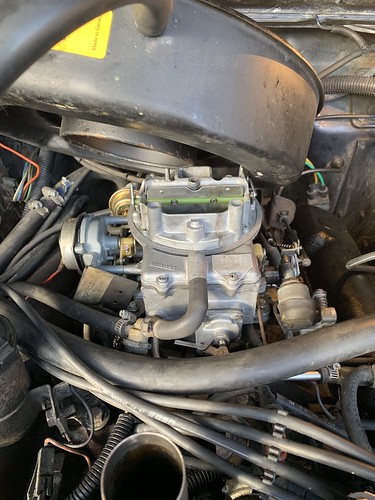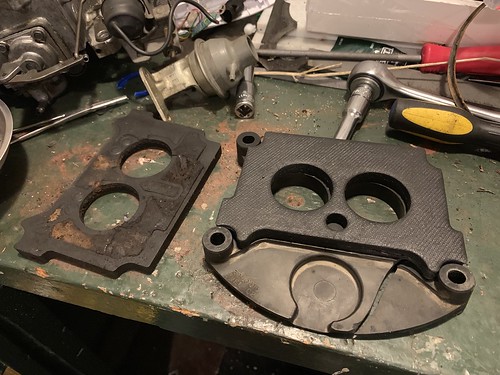Need some ideas regarding a new issue that's got me a little puzzled. My 89 GW, which is bone stock with all emissions equipment intact, has recently started giving me problems with hard hot starts after replacing the carb.
Original carb was running fine however noticed a drop in vacuum to about 14 or so. Hooked up the smoke machine and found leak at the driver side gasket. Removed the carb and and installed new manifold to spacer gasket and spacer to carb gasket. Was not planning on rebuilding the carb or changing it. I reinstalled the carb (torqued to 15 ftlb) only to discover that the spacer had cracked and the accelerator pump was now leaking. This was the original carburetor that came when the car was new(5RHA2) judging by the both choke plate tag and manufacturing date and carb tag. In any case, I happened to have another 5RHA2 with another spacer that I had personally rebuilt. I installed that one and dialed it in to get 19 hg of vacuum. Everything works flawlessly and the car cold starts and runs fine, actually better than before. However, now when hot it will barely start but once started it will run fine. It takes a lot of cranking( 1- 2 min) with careful throttling to get it to finally fire.
Everything is exactly the same as before. I checked the timing and it's still at 12 deg. I clean in a professional ultrasonic cleaner followed by chemical dip. I used an original power valve in the rebuild which I tested with a vacuum pump before install. I also test my rebuilds with mineral spirits to check pump circuit so I know there is no issue there. I measure my float with a micrometer it's set to spec for an 89 per the shop manual. The idle mixture screws adjust fine.
The only thing I think might be the issue, is the second spacer that I installed is also 30 years old and I heard it crack when I torqued the nuts (trust me I really do use a torque wrench) There are no vacuum leaks there but I'm wondering if that would be enough to cause heat issues and the hot starting problems? I will pull the carb again next week and install a brand new spacer and change the power valve just in case, but was wondering if anyone had any other thoughts?
I've combed through innumerable previous threads but can't find any other ideas.
Edit: exhaust heat riser is operational as well as airhorn heat stove, always have been. The choke is fully open when warm.
Original carb was running fine however noticed a drop in vacuum to about 14 or so. Hooked up the smoke machine and found leak at the driver side gasket. Removed the carb and and installed new manifold to spacer gasket and spacer to carb gasket. Was not planning on rebuilding the carb or changing it. I reinstalled the carb (torqued to 15 ftlb) only to discover that the spacer had cracked and the accelerator pump was now leaking. This was the original carburetor that came when the car was new(5RHA2) judging by the both choke plate tag and manufacturing date and carb tag. In any case, I happened to have another 5RHA2 with another spacer that I had personally rebuilt. I installed that one and dialed it in to get 19 hg of vacuum. Everything works flawlessly and the car cold starts and runs fine, actually better than before. However, now when hot it will barely start but once started it will run fine. It takes a lot of cranking( 1- 2 min) with careful throttling to get it to finally fire.
Everything is exactly the same as before. I checked the timing and it's still at 12 deg. I clean in a professional ultrasonic cleaner followed by chemical dip. I used an original power valve in the rebuild which I tested with a vacuum pump before install. I also test my rebuilds with mineral spirits to check pump circuit so I know there is no issue there. I measure my float with a micrometer it's set to spec for an 89 per the shop manual. The idle mixture screws adjust fine.
The only thing I think might be the issue, is the second spacer that I installed is also 30 years old and I heard it crack when I torqued the nuts (trust me I really do use a torque wrench) There are no vacuum leaks there but I'm wondering if that would be enough to cause heat issues and the hot starting problems? I will pull the carb again next week and install a brand new spacer and change the power valve just in case, but was wondering if anyone had any other thoughts?
I've combed through innumerable previous threads but can't find any other ideas.
Edit: exhaust heat riser is operational as well as airhorn heat stove, always have been. The choke is fully open when warm.













Comment